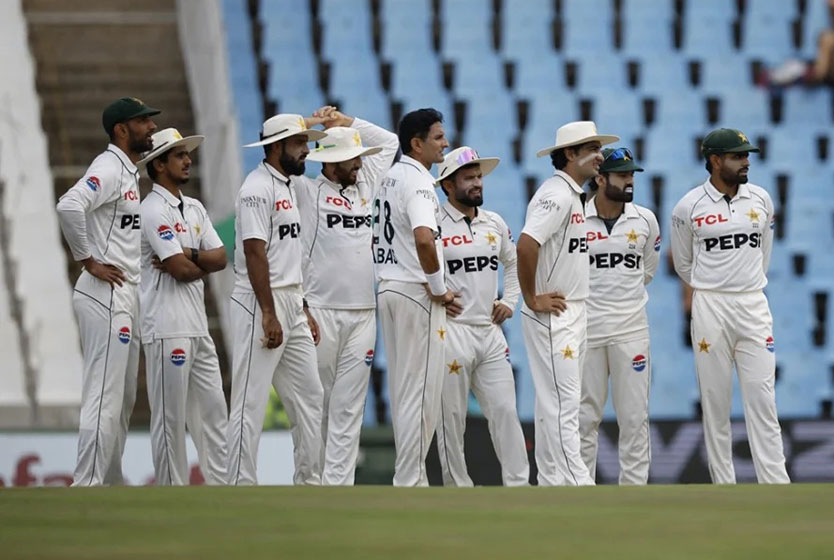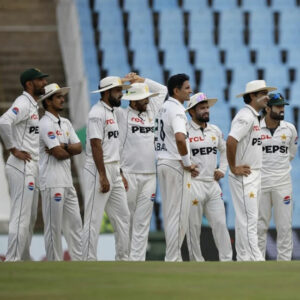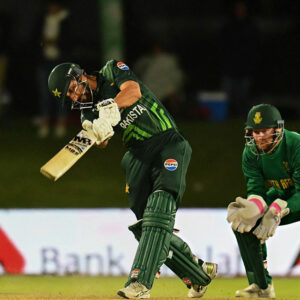
Pakistan, Test Cricket, and the Bits and Pieces
It has become some sort of a custom, a calming ritual: sitting down with a defeat like it’s the morning paper and trying to break the coverage of the wreckage apart. Tally the damage against what was salvaged, and with the pad of a finger running under the words, glasses fixed onto the text, try to figure out what went wrong. The act of figuring out where to allocate blame has recently been the hottest commodity in Pakistan cricket – mostly because it’s one that gets used the most.
Pakistan playing Test matches, especially away, has become somewhat a recital of a rehearsed trauma. The dial is always turned to somewhere between glory and a thorough battering. If we’re lucky, some sick force keeps twisting it agonizingly close to the glory end, only to turn it back to a humbling.
The past two or so years have been even busier than is characteristic for Pakistan cricket, which is already a lot. If the cricketing ecosystem in the country were a kitchen, then the most used appliance would have been a blender, pulsing everything into a mush drinkable from a straw at the slightest sign of adversity. I think (online, offline, sensical, nonsense) discourse has been the 12th man in all of Pakistan’s teams recently, the extra slicer at the bottom of a food processor. There are those who think the failures are underscored by terrible batting performances, and there are those who insist that waywardness and indiscipline with the ball is what is costing the team match after close match. Some hug the comfortable cushion of “Pakistan is just not a fielding side,” and some prefer to blanket everything in mercuriality and the team’s infamous unpredictability.
I think that none of these problems exist to the extent people think they do – but each of them exists on enough of a level to be a problem when pooled together.
The problem with treating either the batting or the bowling for a team’s prolonged lack of success is that it pits the two as compensatory units for each other. It implies that the batting must persist and show up when the bowling can’t be relied on for control, and it implies that when the batting falters, the bowling has to dig the team out. And all of that is true, of course; that’s how a team works – it has to internally overcome its shortcomings to put together a cohesive performance. But the problem with a team as textured as Pakistan, with fans as passionate, is that people tend to think of the bowling and batting as separate teams within the team. When that happens, it is easy to give into the impression that a team is competing within itself – if the bowlers do their job, they can be let off the hook. If the batters do, it’s their turn to gloat.
In the first innings in Centurion, the top order falters, but the batting line-up seizes just enough for the bowlers to have something to play with. The bowlers pull it back spectacularly but deflate when it comes to getting the tail out, which eventually means that South Africa get a lead. In the second innings, while Saud gives his all to muster a sizeable total for the opposition to chase, most of the line-up falls to their dismissals on unnecessary shots played on innocuous deliveries. And while the bowlers do their best to make a game out of a sure defeat through Mohammad Abbas’ brilliance, they once again flatten when it is time to cut through the pressure.
This is not the first time this has happened – Pakistan has made a habit of creating games out of nothing, indicating that they are clearly skilled and capable of doing so, but has let them go when it mattered the most. Often you see bowlers having almost defended an undefendable target, or the batters almost having set themselves up for a mammoth score, or the fielders almost taking the screamers and the rippers. Often, matches that should have been lost fairly easily are turned into those that are impossible to lose, only to end up as losses anyway.
What Pakistan cricket lacks is not batting or bowling prowess – though those exist in their designated amounts, anyway – it is a sharpness in understanding what has to be overcome when. Would the batters have less deficit to cover, had the bowlers controlled the tail? Would the bowlers have more to defend, had the batters not thrown it away? When it comes to a team like Pakistan, which often presents itself as a makeshift, bits-and-pieces team – batters played out of order, inexperienced bowlers thrust in to replace injured ones, condition-conducive players inexplicably dropped by the management – there is a good chance that Pakistan shows up on game-day fielding a less-than-ideal XI. But a team is still a team, and it must play as such. Batters and bowlers don’t compete for the “who did their job best” trophy or the “who fixed the other’s mess” award. It is tempting to fall into the rhetoric of picking a side – but when a team is good in scraps, it must also know which scraps are to be put together to make a whole.
I think that what Pakistan suffers from, especially in Test cricket, is a half-heartedness to see things through. Fifties don’t turn into hundreds, eight-downs don’t turn into all-outs, and moments of brilliance remain isolated in their conquest to deliver. And while it is encouraging for a team to manufacture competitiveness at times when no one expects them to, it has to be remembered that, more often than not, competitiveness in sport is not enough: it is the bare minimum, and getting over the line is the main objective.
A better cricket-watcher would have an idea of how to remedy the persistence of these heartbreaks, of finally threading the final stitch of all those almosts. The only thing I have to offer, however, is a wistful plea that one day, my team shows up with all of it switched on.







Leave a Reply